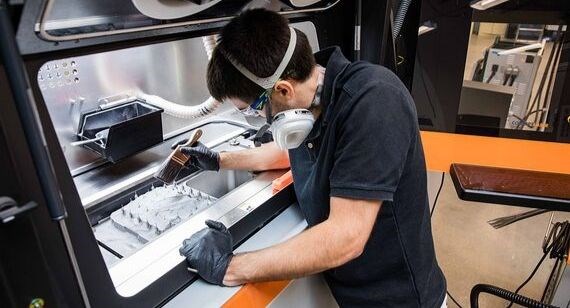Create Jigs and Fixtures with CNC Machining and 3D Printing
Jigs and fixtures often serve as key production floor manufacturing tools that can help streamline part assembly, create efficient workflow processes, improve overall manufacturing quality, help reduce production costs, and automate work.
This post takes a look at the difference between jigs and fixtures. Although jigs and fixtures are most commonly produced by using CNC machining, this post also explores how industrial-grade 3D printing (additive manufacturing) can be an excellent option or alternative to machining when irregular, intricate, or smaller jigs and fixtures are called for.

Jigs Aid Manual Processes
Manufacturers may use various types of jigs for a variety of tasks inside manufacturing equipment, but, essentially, a jig holds and guides the position of a tool in order to perform a manufacturing task. Drill bushings are a good example, helping guide a drill through a workpiece to maintain accurate positioning and angle. A drill bushing can lead to higher quality work and also increase manufacturing speed.
Fixtures Help Automated Processes
Rather than guiding a manufacturing tool, fixtures hold a workpiece in a secure position, orientation, or location. A common machining example is the fixture in which a block of raw material is clamped inside a CNC machine. Fixtures are key manufacturing tools that enable automation. An automobile assembly line, for example, is made possible by the fixtures that secure and move cars through the welding and assembly process. Additionally, they are often used to hold a product in place for optical and laser scanning to assess manufacturing quality. Indeed, you’d be hard pressed to find an automated industrial process that doesn’t involve fixtures.
Combining Jigs and Fixtures
Using jigs and fixtures together helps achieve manufacturing precision for products to function properly. Examples? Consider doors, cabinets, and shelving. The holes for the door’s knob, latch, and hinges require precision placement and guidance for drilling. The same applies with cabinets with dovetail cuts or the shelving holes on the cabinet sides. Without jigs and fixtures, books would slide off shelves, drawers would be flimsy, doors wouldn’t close properly…well, you get the idea.
As mentioned, machining is the most common manufacturing process for creating jigs and fixtures. For design considerations and guidelines, Brazil Metal Parts is able to maintain tolerances of ±0.005 in. (0.127mm).
Finally, not all jigs and fixtures need to be made of metal. In many cases, plastic can reduce costs and meet your performance requirements.
3D Printing Options for Jigs, Fixtures
Beyond machining, industrial-grade 3D printing can also be a viable option for jigs and fixtures, and, again, both in metal or plastic. This is especially the case when the geometry is too difficult or costly to machine. The key is choosing which technology fits better for a particular application.
The general rule is: if it can be 3-axis CNC machined, it should be machined. Machined fixtures usually have superior surface finishes, stronger materials, and greater accuracy. Also, for lower volume runs, costs and turnaround times are about the same as 3D printing.
As mentioned, 3D printing comes in to play when jigs and fixtures have irregular or complex shapers or are smaller than usual. In addition, when producing multiple jigs and fixtures, 3D printing can be a good way to keep costs down.
One of our recent design tips outlines which of our 3D printing processes fits best for particular jig/fixtures applications.
For plastic jigs and fixtures, stereolithography (SL) is a popular option for building smaller, complex jigs and fixtures, because of the excellent surface finish possible on final components. Selective laser sintering (SLS) is used more regularly for larger jigs and fixtures, producing durable and accurate pieces that are stronger than those made with SL. SLS also offers a larger build volume but parts will have a rough finish and lack finer details. Multi Jet Fusion is also becoming increasingly popular for producing jigs and fixtures—producing functional nylon prototypes and end-use production parts in as little as a day.
For 3D printing metal jigs and fixtures, direct metal laser sintering (DMLS) can produce extremely durable items. DMLS surfaces, though, tend to be rough and turnaround times are longer because of post-processing requirements.
As always, with any of our tech tips, feel free to contact one of our applications engineers at +86-755-29729151 or [email protected] with questions or to discuss options or get advice. To get your next design project started today, simply upload a 3D CAD model for an interactive quote within hours.